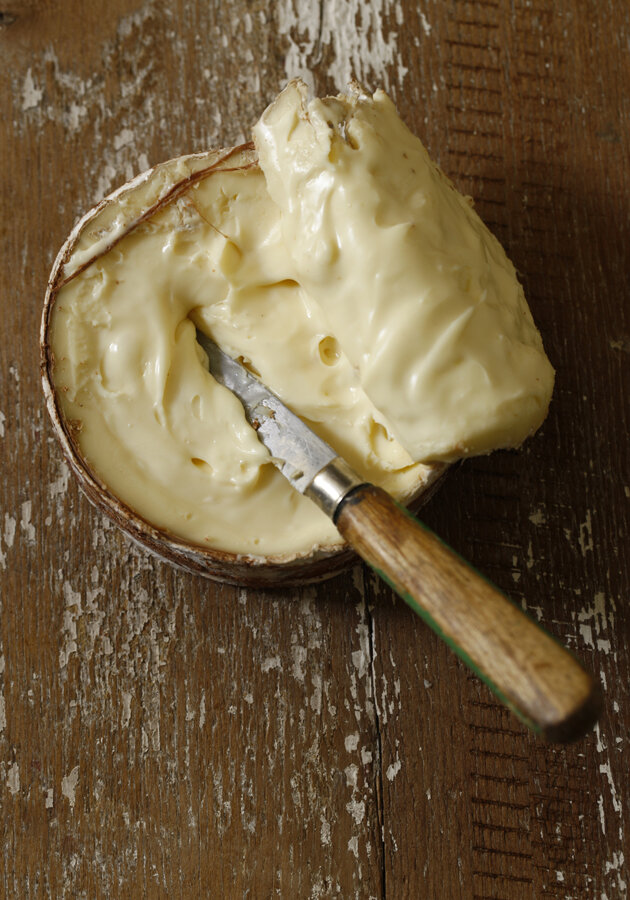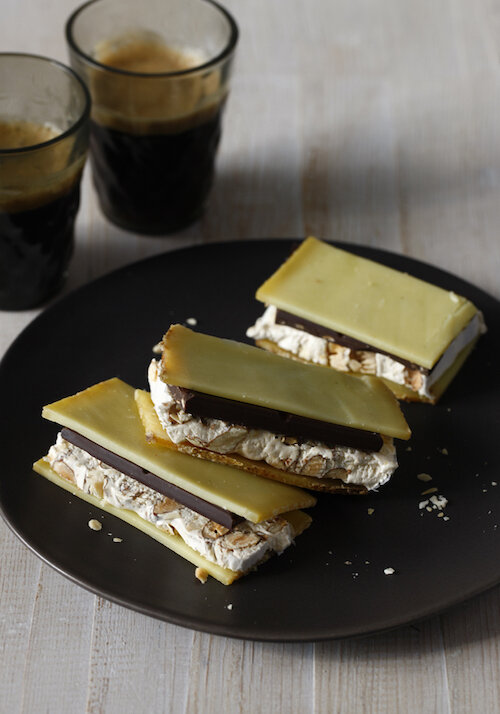Why We Love Di Bruno Bros. House of Cheese by Tenaya Darlington
Cheese writer Tenaya Darlington set about advancing her own knowledge of cheese by tasting her way through the case at her local cheesemonger: Philadelphia’s Di Bruno Bros. A worthy endeavor, to say the least. And then, lucky for the rest of us, she cataloged those cheeses in her cheese guide-meets-memoir: Di Bruno Bros. House of Cheese: A Guide to Wedges, Recipes, and Pairings.
You know you’re in capable hands from the preface, delightfully entitled “The Birth of a Cheese Courtesan.” Darlington lovingly refers to cheeses as “hunks,” double meaning always intended, to remind you that the greatest cheeses are equally swoon-worthy. She paints a humble yet entertaining picture of the beginning of her journey as someone who thought she knew a thing or two about curds, being a recently transplanted Wisconsinite, but who was out of her depth when faced with the volume of hunks on offer at Di Bruno Bros. A beautiful relationship was forged between herself and the cheesemongers—whom she assumes to be Cheese Bouncers before learning otherwise—when she bravely uttered those four words that help set promising cheese novices apart from mere cheddarheads: “I like strong cheese.”
House of Cheese doesn’t spend a lot of real estate on the nuts and bolts, (read: curds and whey,) of cheese making, scientific variations among animal milks, or world cheese geography, but is regardless an excellent guide for the cheese curious, from beginner to expert. Here are four reasons to commit to this charming manifesto born of Darlington’s penchant for “nibbling and scribbling.”
Curd Words
Burrata
If you’ve ever dove into a tasting guide for any category: wine, beer, chocolate, etc., you’ll know it’s hard to keep the language fresh when describing multiple selections that have more similarities among them than differences. Without having read the complete library of all that is devoted to cheese, I’ll still go on record and say Darlington is a better wordsmith where cheese is concerned—curdsmith?—than anyone else out there. She effectively describes the vibe of each cheese in one or two succinct paragraphs, easily bringing them to life with evocative terminology which often goes beyond the traditional cheese tasting lexicon.
I spent time selling cheese to a fine dining public, and I never came up with as good a word for strong-aroma cheeses that are somehow both off-putting and alluring like the perfect one Darlington offers: whiffy. Other terminology and syntax gems among the pages include pudgy, gory, fudgy, zaftig, goth, “downy log of sexy sexiness,” “breath like warm onion bagels,” “tricksy little beefcake,” and “sumptuous goo.” In short, even if you don’t care a whiff about cheese, it’s fun to read.
Personality
Harbison
Most cheese catalogs divide cheeses along certain lines, whether by cheesemaking process, by shared geography, or by animal milk and/or diet. Darlington does none of those outright, instead offering 10 headings for her catalog along the lines of distinct cheese personalities; basically how the cheeses within the same personality share similarities of impact on one’s palate for both taste and texture.
Sometimes they do fall along geographical lines: most of the madames in the Vixens are French and the Wise Guys are primarily Italian; sometimes they fall within the realms of a cheese-making process: the whiffy bastards in the Stinkers category are typically washed-rind numbers; and sometimes animal milk creates a ruling personality trait: one must have a certain goat-like—or “caprine”—joie de vivre to really be a Free Spirit. But her vibrant system allows ample room for exceptions and outliers; there are blue cheeses in numerous categories, for example.
And, in giving cheeses personalities, the book itself has a massive personality. Where else are you going to meet characters like “a lingerie model, rich and almost unbearably smooth,” (mascarpone), “a home-schooled hitchhiker with psychedelic fur,” (tomme crayeuse), “a rural princess with a potty mouth,” (Hooligan), and “a royal weirdo, a blue blood with crazy taste,” (bleu des Basques).
Learning Process
“If you don’t know what we’re talking about, just trust our enthusiasm,” says Darlington, regarding a certain cheese that she recommends for lovers of another certain cheese. This also applies if you are more fresh curd than cave-aged when it comes to cheese appreciation.
As mentioned, this book does not begin at the beginning of the cheesemaking process, so if you’re looking for an easy answer to “mommy, where does cheese come from?” you won’t get it in plain text. But you’ll probably still get it by following along. The language isn’t written to separate the in-the-know from the not-in-the-know like so many curds from the whey. There’s something to be said here for learning much in the same way Darlington herself did, by exploration.
Given well-structured context clues, you’ll know immediately what terms like “caprine” and “creamline” refer to. The clever organization of the book will help illustrate what terms like “washed rind” mean, in terms of who’s doing the washing and what they are washing with. You’ll probably even be able to surmise that “washing” doesn’t have much to do with cleaning, since these cheeses come out a little on the funky side.
Practical sidebars contained throughout also highlight recipes, cheese handling suggestions, cheese plate inspiration, and cheesemaker profiles, among other insightful sections.
Pairings
Cheese pairings aren’t new to the written word, whether in terms of beverages or complementary foods. Darlington offers both for each of the cheeses featured, offering traditional selections alongside those that are born of a certain open-mindedness. Much has been written about wine and beer pairings with cheese, for instance, but Darlington goes a step further and often suggests spirits or cocktails from absinthe to martinis. Food companions range from usual suspects such as baguettes and honey, to inspired ideas like caramelized endive marmalade and Armenian pickled walnuts.
More so than just the actual food pairings, however, one of my favorite aspects of this book is how Darlington is able to draw connections between cheeses and moods, pairing cheese not only with food and drink, but with where, when, how, or with whom. On one hand, this can help to further contextualize cheeses within the scope of how they may have been traditionally consumed given their various pedigree, and on the other, it’s just really damn charming.
It’s not hard to imagine that certain cheeses could indeed be enhanced by being eaten “on a park bench in spring,” or “at an outdoor concert,” or by being employed for “bargaining with the heart of a jilted lover.”
Frankly, I just don’t know how to even argue with ultra-specific recommendations like, “On a nice day, when you’re having an ‘Umbrellas of Cherbourg’ moment, grab a chipped plate and eat this cheese on your fire escape while humming something appropriately melancholy.” This is a great deal more evocative than “goes great with beer,” and encapsulates the magic that is House of Cheese.
For more information about Tenaya Darlington, House of Cheese, and her other books, visit Madame Fromage.




